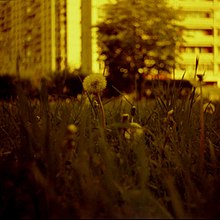Redscale
Redscale [ ˈɹɛdskeɪl ] is a technique from analog photography in which the film used is exposed from the back. Depending on the exposure time and the film, the photos will have a slight yellow tint to a distinct red tint.
Redscale films can be prepared by hand by rewinding, but it is also possible to purchase pre-made Redscale films.
background
Color negative films consist of three color-sensitized layers. During normal use, the incident light first hits the blue-sensitized layer unhindered, and then hits the corresponding green- and red-sensitized layer. Despite color sensitization, however, silver-based film layers always have a residual sensitivity to blue light. Therefore, the blue component of the light is filtered out with a yellow filter or red filter before it hits the green and red sensitized layers .
When used the other way around, the light therefore first passes through these two filters before it hits the blue-sensitized layer. This in turn is only slightly pronounced, while red and yellow dominate.
This effect can be controlled by varying the exposure time . Short exposure times usually produce photos with a strong red-yellow cast, while long exposure times lead to a slight yellow cast. However, the exact behavior depends heavily on the film used.
history
It can be assumed that the appearance of the redscale effect due to accidentally incorrectly inserting the film used ( most likely with sheet film ) has been known for a long time. As a conscious, artistic medium, redscale photography only gained a certain popularity in the last few decades, especially in the course of Lomography .
